Rudraksha
Rudraksha (IAST:Rudrākṣa) is a seed that is used as a prayer bead in Hinduism, especially in Shaivism. When they are ripe, rudraksha seeds are covered by a blue outer shell and are sometimes called blueberry beads.[1] The seeds are produced by several species of large, evergreen, broad-leaved tree in the genus Elaeocarpus, the principle of which is Elaeocarpus ganitrus. The seeds are associated with the Hindu deity Shiva and are commonly worn for protection and for chanting mantras such as Om Namah Shivaya. The seeds are primarily used in India, Indonesia and Nepal as beads for organic jewellery and malas; they are valued similarly to semi-precious stones. Various meanings and interpretations are attributed to beads with different numbers of segments or the locules of seed (mukh) [Sanskrit "मुख": face ], and rare or unique beads are highly prized and valuable.
Etymology
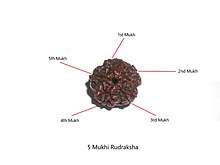
Rudraksha is a Sanskrit compound word consisting of Rudra (Sanskrit: रुद्र) and akṣa (Sanskrit: अक्ष ).[2][3] Rudra is one of Shiva's vedic names and Akṣa means 'teardrops'. Thus, the name means "Lord Rudra's teardrops".
Sources like Satguru Sivaya Subramuniyaswami and Kamal Narayan Seetha translate Akṣa as eye, in which case rudraksha could also mean "Eye of Lord Shiva" or "Eye of Rudra".[4]
Tree
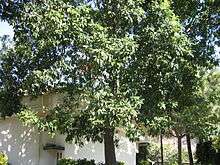
Elaeocarpus ganitrus trees grow to 60–80 ft (18–24 m) and are found from the Gangetic plain in the foothills of the Himalayas to Nepal, South and Southeast Asia, parts of Australia, and Guam and Hawaii.[5] Of the 300 species of Elaeocarpus, 35 are found in India.[6] It is an evergreen tree that grows quickly. The rudraksha tree starts bearing fruit in three to four years from germination. As the tree matures, the roots form buttresses, rising up near the trunk and radiating out along the surface of the ground.
Elaeocarpus ganitrus roxb can be found from sea level to 3,000 m (9,800 ft). It tends to grow in narrow spaces rather than on open ground. Its leaves resemble those of the tamarind or nux vomica but are longer. It yields between 1,000 and 2,000 fruits annually. These fruits are also known as Amritphala (Fruits of Nectar).[7]
Rudraksha seeds are covered with a blue outer husk when fully ripe and are also known as blueberry beads. The blue color is not derived from pigment but is structural.[8]
Types
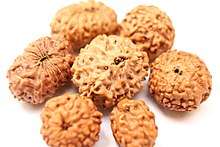
Rudraksha beads have between 1 and 21 lines (mukhi). Recently , a 27-line rudraksha was found in Nepal. 80% of all rudrakshas have four, five (most common) or six lines; those with a single line are rarest. Rudrakshas from Nepal are between 25 and 30 mm (0.98 and 1.18 in) and those from Indonesia are between 25 and 30 mm (0.98 and 1.18 in). Rudrakshas are white, red, brown (most common) yellow, and black.
Gauri Shankar are two rudrakshas naturally joined together. Ganesha have a trunk-like protrusion on their bodies. Sawar is a Gauri Shankar in which one bead has only one line. Trijuti are three rudraksha beads joined naturally. Other rare types include Ved (4 sawars on a bead) and Dwaita (two sawars on a bead).[9]
Composition
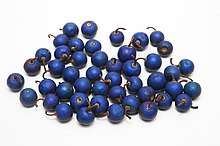
Rudraksha fruits contain alkaloids, flavonoids, tannins, steroids, triterpenes, carbohydrates and cardiac glycosides. They also contain rudrakine[10], a newly discovered alkaloid.
Uses
Rudraksha seeds exhibit pharmacological properties that include anti-inflammatory, analgesic, sedative, antidepressant, anti-asthmatic, hypoglycemic, antihypertensive, smooth muscle relaxant, hydrocholeretic, antiulcerogenic, and anticonvulsant.[11]
In Ayurveda, the bead, bark and leaves of the rudraksha tree, which have antibacterial effects, are used for treating mental disorders, headaches, fever, skin diseases and other ailments. The flesh or pulp of the drupe is administered for epilepsy, diseases of the head and mental illness.
Religious uses
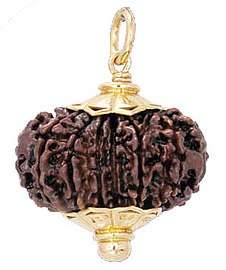
There is a long tradition of wearing 108 rudraksha beads in India, particularly within Shaivism, due to their association with Shiva, who wears rudraksha garlands. The mantra Om Namah Shivaya is repeated (japa) using rudraksha beads.[12] Hindus have used Rudraksha malas as rosaries[13] for meditation purposes and to sanctify the mind, body and soul since the 10th century at the earliest.
Rudraksha beads may be strung together as a mala and used to count the repetition of a mantra or prayer in way similar to the use of rosaries in Christianity. Most garlands contain 108 beads plus one because as 108 is considered sacred and a suitable number of times to recite a short mantra. The extra bead, which is called the "Meru", bindu, or "guru bead", helps mark the beginning and end of a cycle of 108 and has symbolic value as a 'principle' bead. Rudraksha malas usually contain beads in combinations 27+1, 54+1, or 108+1. Devi-Bhagavata Purana describes the preparation of rudraksha mala.[14]:64–65 The beads are commonly strung on silk, or on a black or red cotton thread. Less often, jewellers use copper, silver or gold wires.[15][16] The rudraksha may be damaged if strung too tightly.
In religious texts
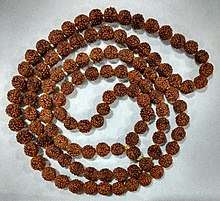
- तं गुहः प्रत्युवाच प्रवालमौक्तिकस्फटिकशङ्ख रजताष्टापदचन्दनपुत्रजीविकाब्जे रुद्राक्षा इति । आदिक्षान्तमूर्तिः सावधानभावा । सौवर्णं राजतं ताम्रं तन्मुखे मुखं तत्पुच्छे पुच्छं तदन्तरावर्तनक्रमेण योजयेत् ।[17] Akshamalika Upanishad
Meaning: Sage Guha replied: (It is made of any one of the following 10 materials) Coral, Pearl, Crystal, Conch, Silver, Gold, Sandal, Putra-Jivika, Lotus, or Rudraksha. Each head must be devoted and thought of as presided over by the deities of Akara to Kshakara. Golden thread should bind the beads through the holes. On its right silver (caps) and left copper. The face of a bead should face, the face of another head and tail, the tail. Thus a circular formation must be made.[18]
- अथ कालाग्निरुद्रं भगवन्तं सनत्कुमारः पप्रच्छाधीहि भगवन्रुद्राक्षधारणविधिं स होवाच रुद्रस्य नयनादुत्पन्ना रुद्राक्षा इति लोके ख्यायन्ते सदाशिवः संहारकाले संहारं कृत्वा संहाराक्षं मुकुलीकरोति तन्नयनाज्जाता रुद्राक्षा इति होवाच तस्माद्रुद्राक्षत्वमिति तद्रुद्राक्षे वाग्विषये कृते दशगोप्रदानेन यत्फलमवाप्नोति तत्फलमश्नुते स एष भस्मज्योती रुद्राक्ष इति तद्रुद्राक्षं करेण स्पृष्ट्वा धारणमात्रेण द्विसहस्रगोप्रदानफलं भवति । तद्रुद्राक्षे एकादशरुद्रत्वं च गच्छति । तद्रुद्राक्षे शिरसि धार्यमाणे कोटिगोप्रदानफलं भवति ।[19] Brihajjabala Upanishad
Meaning: Sage Sanatkumara approached Lord Kalagni Rudra and asked him, "Lord, kindly explain to me the method of wearing Rudraksha." What he told him was, "Rudraksha became famous by that name because initially, it was produced from the eyes of Rudra. During the time of destruction and after the act of destruction, when Rudra closed his eye of destruction, Rudraksha was produced from that eye. That is the Rudraksha property of Rudraksha. Just by touching and wearing this Rudraksha, one gets the same effect of giving in charity one thousand cows."[20]
- तुलसीपारिजातश्रीवृक्षमूलादिकस्थले । पद्माक्षतुलसीकाष्ठरुद्राक्षकृतमालया ॥[21] Rama Rahasya Upanishad
Meaning: He should count using a rosary (mala) whose beads are either made of the tulsi plant or rudraksha.[22]
- हृदयं कुण्डली भस्मरुद्राक्षगणदर्शनम् । तारसारं महावाक्यं पञ्चब्रह्माग्निहोत्रकम् ॥[23] Rudrahridaya Upanishad
Meaning: After prostrating himself before the celebrated form of Sri Mahadeva-Rudra in his heart, adoring the sacred Bhasma and Rudraksha and mentally reciting the great Mahavakya-Mantra, Tarasara, Sage Shuka asked his father Geat Sage Vyasa[24]
- अथ हैनं कालाग्निरुद्रं भुसुण्डः पप्रच्छ कथं रुद्राक्षोत्पत्तिः । तद्धारणात्किं फलमिति । तं होवाच भगवान्कालाग्निरुद्रः । त्रिपुरवधार्थमहं निमीलिताक्षोऽभवम् ।निमीलिताक्षोऽभवम् तेभ्यो जलबिन्दवो भूमौ पतितास्ते रुद्राक्षा जाताः । सर्वानुग्रहार्थाय तेषां नामोच्चारणमात्रेण दशगोप्रदानफलं दर्शनस्पर्शनाभ्यां द्विगुणं फलमत ऊर्ध्वं वक्तुं न शक्नोमि ।[25] Rudrakshajabala Upanishad
Meaning: Sage Bhusunda questioned Lord Kalagni-Rudra: What is the beginning of Rudraksha beads? What is the benefit of wearing them on the body? Lord Kalagni-Rudra answered him thus: I closed my eyes for the sake of destroying the Tripurasura. From my eyes thus closed, drops of water fell on the earth. These drops of tears turned into Rudrakshas. By the mere utterance of the name of 'Rudraksha', one acquires the benefit of giving ten cows in charity. By seeing and touching it, one attains double that benefit. I am unable to praise it any more.[26]
- They who walk the twin paths of charya and kriya ever praise the twin feet of the Lord. They wear holy emblems—the twin rings in earlobes, the twin rudraksha garland around the neck—and adopt the twin mudras, all in amiable constancy. Tirumantiram 1423. TM[27]
- Thinking of Him, great love welling up in their heart, if they finger the rudraksha beads, it will bring them the glory of the Gods. Chant our naked Lord’s name. Say, “Namah Shivaya!” : Tirumurai 3.307.3. PS, 217[28]
Gallery
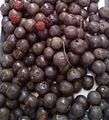 On drying, Rudraksh fruits turns black
On drying, Rudraksh fruits turns black- Rudraksha tree leaves
 Rudraksha tree with flowers
Rudraksha tree with flowers Freshly plucked raw Rudraksha fruit. When ripe these are blue in color.
Freshly plucked raw Rudraksha fruit. When ripe these are blue in color.- Raw Rudraksha fruit on the tree
 RudrakshaRupin.
RudrakshaRupin.- Rudraksha flower at close.
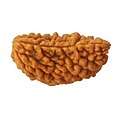 1 mukhi rudraksha
1 mukhi rudraksha 13 mukhi rudraksha
13 mukhi rudraksha Rudrakshas in a heart-shaped pod of neighbouring tree
Rudrakshas in a heart-shaped pod of neighbouring tree 7 Mukhi Rudraksha cut into half
7 Mukhi Rudraksha cut into half X-ray of 10 mukhi Rudraksha reveals 10 seeds storing chambers and one central chamber in the Rudraksha
X-ray of 10 mukhi Rudraksha reveals 10 seeds storing chambers and one central chamber in the Rudraksha Countries to which Elaeocarpus ganitreus Roxb is native.
Countries to which Elaeocarpus ganitreus Roxb is native.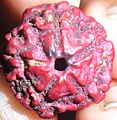 Panchamukhi Rudraksha
Panchamukhi Rudraksha
See also
| Wikimedia Commons has media related to Rudraksha. |
- Prayer beads
- Buddha chitta mala
- Buddhist prayer beads
- Hindu prayer beads
- Phuang malai
- Tasbeeh
- Other malas
- Mantras
- Aum Namah Shivaya
- Om mani padme hum
- Tantra
- Related concepts
References
- Singh, B; Chopra, A; Ishar, MP; Sharma, A; Raj, T (2010). "Pharmacognostic and antifungal investigations of Elaeocarpus ganitrus (Rudrakasha)". Indian J Pharm Sci. 72 (2): 261–5. doi:10.4103/0250-474X.65021. PMC 2929793. PMID 20838538.
- The translation of rudrākṣa as "Rudra's Teardrops" and definition as berries of Elaeocarpus ganitrus see: Stutley, p. 119.
- Stutley, M. (1985). The Illustrated Dictionary of Hindu Iconography. New Delhi, India: Munshiram Manoharlal Publishers. ISBN 978-81-215-1087-5.
- Subramuniyaswami, Sivaya (1997). Dancing with Siva. USA. Search for "Rudraksha"in the page. ISBN 9780945497974.
- Koul, M. K. (2001-05-13). "Bond with the beads". Spectrum. India: The Tribune.
- Cite |url=https://powerofrudraksha.blogspot.com/
- Source : Sanatan's Holy text Shiva
- Lee, D. W. (1991). "Ultrastructural Basis and Function of Iridescent Blue Color of Fruits in Elaeocarpus". Nature. 349 (6306): 260–262. doi:10.1038/349260a0.
- Seetha, Kamal Narayan (2005). Power of rudraksha. India. pp. 15, 20 and 21. ISBN 9788179929810.
- "Rudrakine chemical" (PDF). Research gate.
- "A Review on Medicinal Properties of Elaeocarpus ganitrus Roxb.ex G. Don. (Elaeocarpaceae)".
- "Dancing with Siva". www.himalayanacademy.com. Retrieved 2018-04-07.
- Laatsch, M. (2010). Rudraksha. Die Perlen der shivaitischen Gebetsschnur in altertümlichen und modernen Quellen. Munich: Akademische Verlagsgemeinschaft München. ISBN 978-3-89975-411-7.
- Seetha, Kamal Narayan. Power of Rudraksha (PDF). ISBN 9788179929810. Retrieved 2009-01-01.
- For the five-division type as signifying Shiva's five faces and terminology pañcānana, see: Stutley, p. 119.
- Seetha, K. N. (2008). Power of Rudraksha (4th ed.). Mumbai, India: Jaico Publishing House. ISBN 978-81-7992-844-8.
- "AkShamalika Upanishad sanskrit\" (PDF).
- "AkShamalika Upanishad english".
- "Brihat-Jabala Upanishad sanskrit".
- "Brihad Jabala Upanishad english".
- "shrIRamarahasya Upanishad sanskrit".
- "Rama Rahasya Upanishad english".
- "Rudrahridaya Upanishad sanskrit".
- "Rudra Hridaya Upanishad english".
- "rudrakshajabala sanskrit" (PDF).
- "Rudraksha Jabala Upanishad english".
- Dancing with Siva. Himalayan Academy. 1997. ISBN 9788120832657.
- Dancing with Siva. Himalayan Academy. 1997. ISBN 9780945497479.